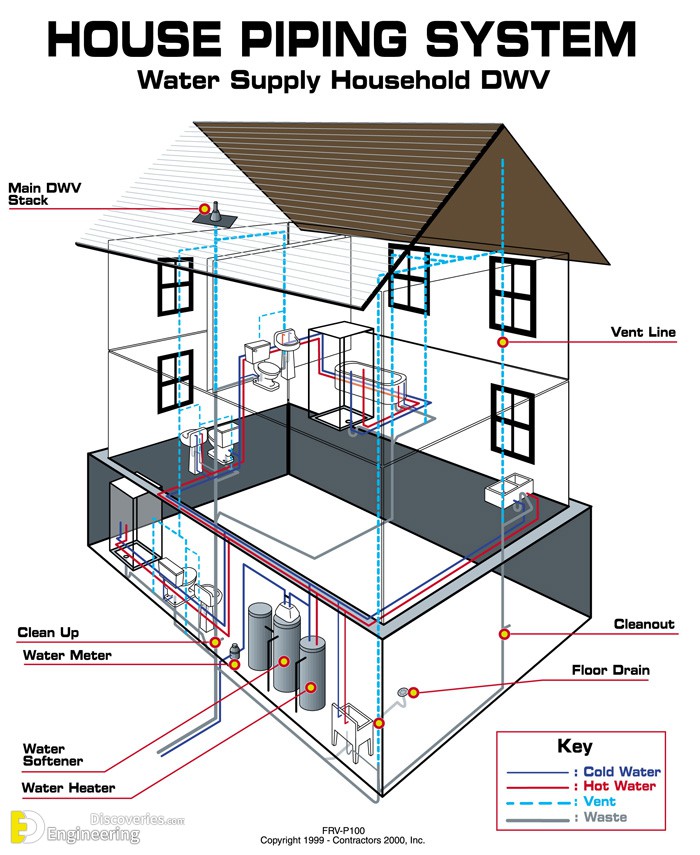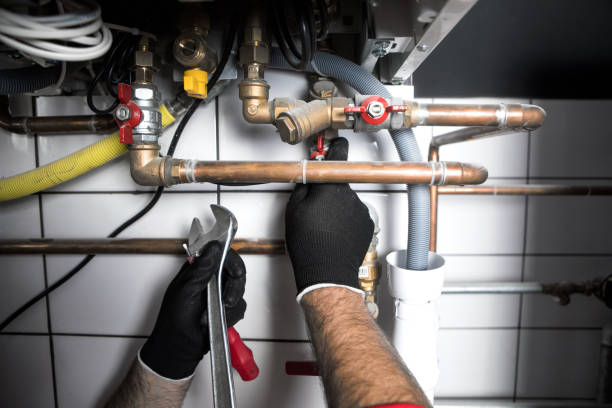Understanding The Structure of Your House's Plumbing System
Understanding The Structure of Your House's Plumbing System
Blog Article
How do you feel in regards to Plumbing Installation 101: All You Need to Know?

Comprehending just how your home's pipes system works is essential for every home owner. From providing tidy water for alcohol consumption, cooking, and bathing to safely getting rid of wastewater, a properly maintained plumbing system is critical for your family's wellness and comfort. In this thorough guide, we'll check out the elaborate network that composes your home's plumbing and deal ideas on maintenance, upgrades, and managing usual problems.
Introduction
Your home's pipes system is more than just a network of pipelines; it's a complicated system that guarantees you have accessibility to tidy water and efficient wastewater elimination. Understanding its parts and exactly how they work together can aid you prevent pricey repair work and make sure everything runs efficiently.
Basic Elements of a Pipes System
Pipes and Tubing
At the heart of your pipes system are the pipes and tubing that carry water throughout your home. These can be made of different materials such as copper, PVC, or PEX, each with its benefits in terms of sturdiness and cost-effectiveness.
Fixtures: Sinks, Toilets, Showers, and so on.
Components like sinks, toilets, showers, and bathtubs are where water is utilized in your home. Understanding exactly how these components attach to the plumbing system helps in identifying troubles and intending upgrades.
Valves and Shut-off Points
Valves control the flow of water in your plumbing system. Shut-off shutoffs are critical throughout emergencies or when you require to make repairs, allowing you to isolate parts of the system without interrupting water flow to the whole house.
Supply Of Water System
Key Water Line
The primary water line attaches your home to the local water system or an exclusive well. It's where water enters your home and is distributed to various fixtures.
Water Meter and Stress Regulatory Authority
The water meter measures your water use, while a pressure regulatory authority makes certain that water moves at a secure stress throughout your home's pipes system, protecting against damages to pipelines and fixtures.
Cold Water vs. Warm water Lines
Comprehending the distinction between cold water lines, which supply water directly from the major, and warm water lines, which lug warmed water from the hot water heater, assists in fixing and preparing for upgrades.
Drain System
Drain Pipes and Traps
Drain pipelines lug wastewater far from sinks, showers, and bathrooms to the sewer or septic tank. Catches protect against drain gases from entering your home and additionally trap debris that could create obstructions.
Air flow Pipelines
Ventilation pipelines permit air into the drainage system, preventing suction that can reduce drain and trigger traps to vacant. Correct air flow is necessary for maintaining the integrity of your pipes system.
Significance of Correct Water Drainage
Making sure correct water drainage prevents back-ups and water damages. On a regular basis cleaning up drains and preserving catches can avoid costly repair work and expand the life of your pipes system.
Water Heating Unit
Types of Water Heaters
Water heaters can be tankless or typical tank-style. Tankless heaters warmth water as needed, while tanks keep heated water for immediate use.
Just How Water Heaters Link to the Pipes System
Comprehending how hot water heater connect to both the cold water supply and warm water distribution lines aids in diagnosing problems like insufficient warm water or leaks.
Upkeep Tips for Water Heaters
Frequently purging your water heater to eliminate debris, inspecting the temperature setups, and examining for leaks can expand its life expectancy and improve power performance.
Typical Plumbing Concerns
Leakages and Their Causes
Leaks can occur as a result of aging pipelines, loose fittings, or high water stress. Dealing with leaks immediately avoids water damage and mold and mildew development.
Clogs and Obstructions
Obstructions in drains pipes and commodes are typically brought on by flushing non-flushable things or an accumulation of oil and hair. Using drainpipe screens and bearing in mind what decreases your drains can protect against blockages.
Signs of Pipes Troubles to Look For
Low water pressure, slow drains, foul odors, or abnormally high water expenses are indications of possible plumbing issues that should be attended to quickly.
Pipes Maintenance Tips
Routine Inspections and Checks
Arrange yearly pipes inspections to catch problems early. Seek signs of leaks, rust, or mineral accumulation in faucets and showerheads.
Do It Yourself Upkeep Tasks
Simple jobs like cleaning faucet aerators, checking for toilet leaks using dye tablet computers, or shielding revealed pipelines in cool environments can protect against major plumbing problems.
When to Call an Expert Plumbing
Know when a pipes problem needs specialist proficiency. Attempting complex repair work without proper knowledge can result in more damage and higher repair work expenses.
Upgrading Your Plumbing System
Reasons for Upgrading
Upgrading to water-efficient fixtures or replacing old pipelines can improve water quality, lower water costs, and boost the worth of your home.
Modern Pipes Technologies and Their Advantages
Discover modern technologies like clever leakage detectors, water-saving bathrooms, and energy-efficient hot water heater that can conserve money and decrease environmental impact.
Price Factors To Consider and ROI
Determine the in advance expenses versus long-lasting financial savings when taking into consideration pipes upgrades. Lots of upgrades pay for themselves through reduced energy costs and less repair services.
Environmental Influence and Conservation
Water-Saving Fixtures and Appliances
Installing low-flow taps, showerheads, and commodes can substantially reduce water usage without sacrificing efficiency.
Tips for Lowering Water Use
Straightforward behaviors like fixing leaks immediately, taking shorter showers, and running full tons of laundry and meals can conserve water and lower your utility bills.
Eco-Friendly Pipes Options
Take into consideration lasting pipes products like bamboo for floor covering, which is durable and environment-friendly, or recycled glass for counter tops.
Emergency situation Preparedness
Actions to Take During a Plumbing Emergency
Know where your shut-off shutoffs are located and how to switch off the supply of water in case of a burst pipeline or major leak.
Relevance of Having Emergency Contacts Useful
Keep contact details for regional plumbings or emergency situation services conveniently available for fast reaction throughout a plumbing situation.
Do It Yourself Emergency Fixes (When Appropriate).
Temporary solutions like utilizing duct tape to spot a dripping pipeline or placing a bucket under a trickling faucet can minimize damages up until a specialist plumbing technician arrives.
Verdict.
Comprehending the anatomy of your home's pipes system encourages you to maintain it properly, conserving time and money on fixings. By complying with regular upkeep routines and staying notified about modern-day plumbing technologies, you can ensure your pipes system operates successfully for years to find.
Understanding Your Home Plumbing System: A Comprehensive Guide
Plumbing System: The Lifeline of Your Home
At its core, the plumbing system is designed to perform two primary functions: bring fresh water into your home and remove wastewater. The system is a network of pipes, fixtures, and other components that transport water and sewage. Residential plumbing systems include potable water supply lines, drain-waste-vent (DWV) systems, and various plumbing fixtures that make water use in daily tasks possible.
Key Components:
Water Supply: This part of your plumbing system brings municipal water into your home, passing through the main water supply line. It s responsible for supplying all water needs, from drinking to bathing.
Drainage System: It carries waste and water away from your home to the sewer or septic system. This system includes all the piping within your home that leads to external sewage or septic systems.
Vent System: An essential yet often overlooked component, the vent system allows sewer gases to escape and lets air into the drainpipes, ensuring water and waste move correctly through the system.
Fixture: More Than Just Taps and Toilets
Plumbing fixtures are the most interactive parts of the plumbing system, including faucets, showers, toilets, and sinks. Each fixture is connected to the plumbing system and plays a role in either the delivery of freshwater or the disposal of waste and wastewater.
Types of Fixtures:
Faucets and Sinks: Used for washing hands, dishes, and other daily water needs.
Toilets: Dispose of human waste through the sewage system.
Bathtubs and Showers: Provide bathing facilities, requiring both hot and cold water supply.
Water Supply: The Source of Life
The water supply system is a critical component, ensuring that potable water is available throughout your home for various uses, including drinking, cooking, and cleaning. This system consists of pipes that distribute water to different parts of the house, controlled by valves to regulate the water flow.
Types of Plumbing: Materials and Methods
Various types of plumbing systems and materials are used in residential settings, each with its advantages and applications. From copper and PVC pipes for water supply to cast iron and ABS for drainage, the choice of materials can impact the longevity and efficiency of your plumbing system.
https://intownplumbingtx.com/articles/home-plumbing-system-guide/

Understanding Your Home Plumbing System: A Comprehensive Guide
Plumbing System: The Lifeline of Your Home
At its core, the plumbing system is designed to perform two primary functions: bring fresh water into your home and remove wastewater. The system is a network of pipes, fixtures, and other components that transport water and sewage. Residential plumbing systems include potable water supply lines, drain-waste-vent (DWV) systems, and various plumbing fixtures that make water use in daily tasks possible.
Key Components:
Water Supply: This part of your plumbing system brings municipal water into your home, passing through the main water supply line. It s responsible for supplying all water needs, from drinking to bathing.
Drainage System: It carries waste and water away from your home to the sewer or septic system. This system includes all the piping within your home that leads to external sewage or septic systems.
Vent System: An essential yet often overlooked component, the vent system allows sewer gases to escape and lets air into the drainpipes, ensuring water and waste move correctly through the system.
Fixture: More Than Just Taps and Toilets
Plumbing fixtures are the most interactive parts of the plumbing system, including faucets, showers, toilets, and sinks. Each fixture is connected to the plumbing system and plays a role in either the delivery of freshwater or the disposal of waste and wastewater.
Types of Fixtures:
Water Supply: The Source of Life
The water supply system is a critical component, ensuring that potable water is available throughout your home for various uses, including drinking, cooking, and cleaning. This system consists of pipes that distribute water to different parts of the house, controlled by valves to regulate the water flow.
Types of Plumbing: Materials and Methods
Various types of plumbing systems and materials are used in residential settings, each with its advantages and applications. From copper and PVC pipes for water supply to cast iron and ABS for drainage, the choice of materials can impact the longevity and efficiency of your plumbing system.
https://intownplumbingtx.com/articles/home-plumbing-system-guide/
Do you really like reading about ? Create a comment down the page. We will be pleased to know your responses about this blog posting. In hopes that you come back again in the near future. Sharing is nice. Helping people is fun. Thanks a lot for your time spent reading it.
Here Report this page